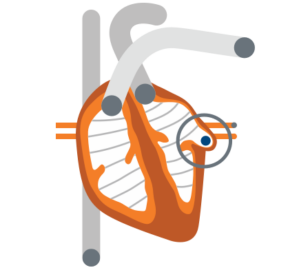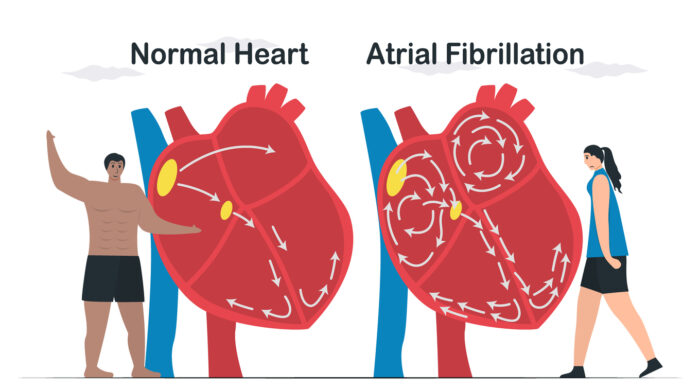Atrial fibrillation (AFib) is the most common type of cardiac arrhythmia. It occurs in 1-2% of the general population and in over 10% of people over age 75. While not directly life threatening, AFib is serious because it puts patients at higher risk for a stroke.
Overall, AFib is associated with a 5x increased risk of stroke. However, the chances of having a stroke varies from patient to patient and is predicted by use of a clinical risk score. For patients who have AFib and a higher risk score, our Cardiologists recommend they go on blood thinners to lower their stroke risk.
For patients who can’t take blood thinners, and have AFib not caused by a heart valve problem, an implanted device called the Watchman may be an alternative to help them lower their risk of stroke.
“For patients who have a reason to not be on a blood thinner, we can offer them the Watchman,” said WWMG interventional cardiologist Ravilla Mahidhar. “In medical terminology, the Watchman device is a left atrial appendage occluder. In simple words, the Watchman device reduces the risk of stroke in patients with atrial fibrillation, which helps them come off blood thinners.”
Blood Thinners vs The Watchman

Image from watchman.com
AFib causes blood to pool in the left atrial appendage of the heart, which can form a clot and lead to stroke. Blood thinners (anticoagulants) prevent the blood clots that can cause a stroke by thinning the blood, reducing its ability to form clots. But that can cause its own problems.
“These blood thinners are not innocuous drugs; they have risks involved. Multiple studies have shown that risk of bleeding is increased in patients who are on long term blood thinners and occasionally this bleeding can be life threatening or fatal,” said Mahidhar.
For patients who can’t tolerate, or should not take long term blood thinners due to risk of bleeding, the Watchman device may be a possible option for preventing stroke.
In the heart, “The left atrial appendage is a small pouch where greater than 90% of clots tend to form. By closing this pouch with the Watchman, we reduce the risk of clot formation,” explained Mahidhar.
Implantation of the Watchman device
The physical approach to preventing clot formation has been around since the turn of the century, but the current Watchman device was approved by the FDA in 2015. Placement of a Watchman does not require open heart surgery; it is an outpatient surgical procedure performed under general anesthesia by an interventional Cardiologist. The Watchman is a permanent device, so requires a one-time surgery at a hospital to implant.
During surgery, the Cardiologist inserts a small (5mm) tube in the patient’s groin that passes through a large vein in the upper leg then up to the heart. The Watchman device is inserted through this tube and placed into the left atrial appendage of the heart. The device is an inert mesh made from a nickel-titanium alloy, and is about the size of a quarter.
After surgery at the hospital, patients are observed for 4-6 hours before they are released. Once home, they need 2-3 days of quiet recovery without driving or lifting anything heavier than 10 lbs. Most patients return to their normal routine after three days. Unlike some medical implants, the Watchman device never needs to be replaced.
“Eventually the heart tissue grows over the device, and it is as if the [left atrial] appendage never existed,” said Mahidhar.
Steps in the Watchman implantation:
Which Patients are Good Candidates for the Watchman
“The Watchman device is not indicated for all AFib patients. It’s indicated for patients who are at higher risk of stroke according to risk scoring criteria and who have a reason to seek a nonpharmacological alternative,” said Mahidhar.
A Cardiologist will only recommend implantation of a Watchman device when a patient meets the following three criteria:
1. Atrial Fibrillation
The Watchman only reduces the risk of stroke in patients who have AFib not caused by a heart valve problem. For patients with other forms of heart disease, blocking the left atrial appendage is not an effective way to reduce the risk of stroke.
2. Elevated stroke risk
Even among AFib patients, some are at higher risk of stroke than others. Cardiologists use a scoring system to estimate stroke risk. Doctors only recommend the Watchman for patients whose score is in the high-risk category.
3. Not a candidate for long-term blood thinners
For most AFib patients, blood thinners continue to be the recommended treatment. Surgical solutions are rarely suggested when medical solutions are available. However, for some patients, the risks of blood thinners are higher. These include patients who have a history of bleeding or elevated risk of severe bleeding, for example: patients who also have balance issues that increase their risk of falling.
Risks of the Watchman
As with any surgical procedure, there are risks associated with implanting a Watchman device. The most serious risks are death, stroke, or complications that could result in the need for open heart surgery.
“It’s very, very rare – it has never happened in our institution. But based upon multiple studies, there is a small chance of a bad outcome. Among 1000 patients who undergo this procedure, three [0.3%] can have a bad outcome,” said Mahidhar.
Benefits
“Patients with atrial fibrillation are at higher risk of having a stroke. And strokes in patients with atrial fibrillation are more likely to be disabling, and more likely to cause mortality, compared to strokes in patients who do not have AFib,” said Mahidhar.
While the risks are small, the benefits of the Watchman are significant for eligible patients.
“Over 95% of patients who have had the Watchman procedure were able to come off blood thinners in 6-8 weeks. The opportunity for patients to come off of blood thinners is a big deal in a vast majority of patients who have AFib and high bleeding risk,” said Mahidhar.
“All patients with atrial fibrillation should talk to their Cardiologist about it. Not all patients with atrial fibrillation need a Watchman, but it’s good to be aware that it exists because if things change, if they develop bleeding issues, they should be educated on this procedure and aware of this option.”
WWMG’s interventional Cardiologists are experts at installing the Watchman device. If you have atrial fibrillation, contact our Cardiology department to request an appointment and find out if the Watchman device is an option for you.
You can learn more about the Watchman in this video:

